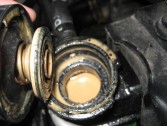
QMotor Mobile App
Find it on the App Store.


Electronic brake control systems are now required standard equipment on cars and trucks. Today, every new vehicle benefits from the optimized braking, enhanced acceleration, and improved stability that these systems provide. Car braking systems maintain the safety of both the driver and the passenger.
There are many different types of car braking systems, and each system works in a different mechanical way: ABS, ABS, ASR, CBC, BAS, and EBD.
Electronic Stability Program (ESP) supports the driver in nearly all critical driving situations. It comprises the functions of the antilock braking system (ABS) and the traction control system, but can do considerably more. It detects vehicle skidding movements, and actively counteracts them. This considerably improves driving safety.
Read more: How to Unlock your Car without Keys!
Anti-lock Braking System (ABS) is a safety system in cars that keeps the wheels from locking up and helps drivers to maintain steering control. It enables the wheels of a vehicle to maintain tractive contact with the ground so that they do not go into an uncontrolled skid.
Acceleration Slip Regulation (ASR) prevents the driving wheels from spinning unnecessary while on slippery surfaces, or when the power coming from the engine is too much for ensuring good traction. It also improves directional control with better traction during high speed cornering.
Cornering Brake Control (CBC) is an active vehicle safety system that assists the driver during maneuvering a curve at high speed. Many vehicle manufacturers consider this system as an extension of Antilock Braking System (ABS).
Further reading: 6 Steps For Long Term Parking
Brake Assist System (BAS) is an active vehicle safety feature designed to help drivers come to a stop more quickly during an episode of emergency braking. Studies show that when making emergency stops, about half of all drivers do not press the brake fast enough or hard enough to make full use of their vehicle’s braking power. BAS is also designed to recognize the tell-tale signs of emergency braking and provide drivers with extra brake support.
Electronic Brake-Force Distribution (EBD) makes use of the data from the speed sensors to know if all the wheels are rotating at the same speed. This system is also capable of comparing the data from a yaw sensor and the steering wheel angle sensor to find out if the vehicle is under or over steering. These data are then processed by the ECU of the braking system to find the load on each of the wheels of the vehicle.
Read more: Stop these wrong beliefs about seatbelt
Sell your used caror buy a carin Qmotor.

The Q Motor team has included some valuable tips for you which will help you pass your driving...

The engine is the most important part of the car at all, and it includes
.jpg)
Names are a large and wide world with many meanings. Our awareness of the things around us...

This guide contains a definition of traffic violations, traffic points system, classification of...
Comments